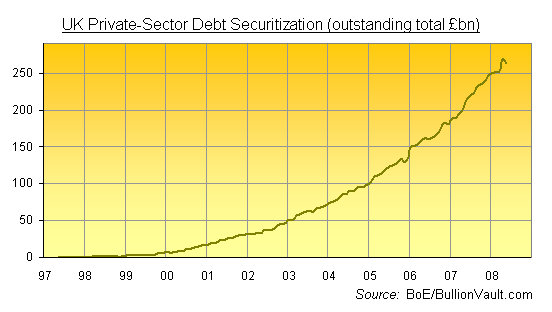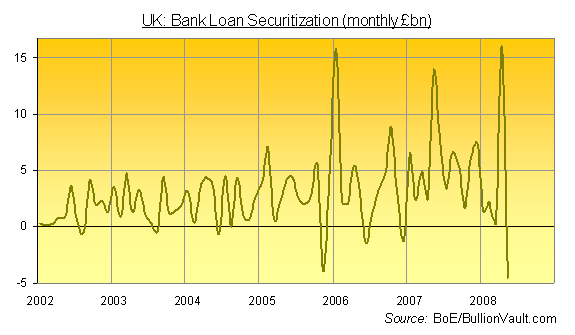Central Banks Buying Securitized Debt to Save Banks from Collapse
Interest-Rates / Credit Crisis 2008 Jun 20, 2008 - 01:35 PM GMTBy: Adrian_Ash
 "...Ninety-five per cent of the credit created by UK banks in May went to buying back loans that they'd already sold to other investors..."
"...Ninety-five per cent of the credit created by UK banks in May went to buying back loans that they'd already sold to other investors..."
BANKS LOOK to lend money. Investors want to get rich. The Pope's been known to attend Mass.
Sounds simple, right? Once you've chosen your wool, just stick to your knitting.
Yet the first two groups – banks and investors – fought so hard to swap clothes in the 10 years to last summer, little wonder they've both now worn holes in their sweaters.

By the end of 2007, lending banks in the UK had converted and sold off some £246 billion ($480bn) of their loans as so-called "securitized" debt. And why not?
After all, a lender collects monthly payments from home-loan or credit card debtors. Bundle enough mortgages or credit-card loans together, and a pension fund manager can then take the role of lender instead. He'll receive those monthly repayments and book them as investment income.
Thus loans made to UK consumers and business – following the hugely successful US example – were parceled and sold onto eager investors wanting a piece of Britain 's own go-go economy. The bank or building society got an immediate return of the money it lent (plus a fee income, of course, split with the investment bankers who arranged the sale). The investor, meantime – whether a pension, insurance, hedge or overseas fund – got a fixed-income asset with a known maturity date, plus a little "payment default" risk to spice up their day.
This magic money-go-round enabled UK banks to make more loans to more people more often. Twenty-one per cent more debt, in fact, than the direct loans they themselves made and then kept on their books.
As for the lenders – now meaning foreign and UK investors – they got to turn a profit from buy-to-let, auto, small business and credit card loans made in Leeds , Lincoln and Lanarkshire. Okay, so they never met the borrowers. Nor did they get to study the borrower's pay slips or credit record. Nor did they see a surveyor's report of the real estate or fixed capital investments underpinning the whole deal.
But that was alright. Because the banks were still judging the risk as though they themselves would end up on the hook. Right?
Come the 2007 surge in sub-prime defaults in the United States , investors finally caught onto what securitization meant for the banks' risk assessment.
Just imagine! Families with low or no income cannot repay jumbo-sized loans! And if those triple-A rated borrowers hit trouble and walk away from their debts, who knows where the next blow-up might come...?
As the panic spread from (apparently) rock-solid US home loans, investors fled new deals in UK debt, too. More crucially still, many previously keen funds also wanted to quit their existing investments.
"Markets for many securities [are] currently closed," noted the Bank of England on 21st April. So "banks have on their balance sheets an 'overhang' of these assets."
The most troublesome assets were mortgages and credit-card debt, plus the "commercial paper" used to refinance securitized debts that the banks themselves held. But with no one to sell to – and no one willing to lend against these assets – "their financial position has been stretched by this overhang," the Bank of England went on, "so banks have been reluctant to make new loans, even to each other."
Hence the collapse in UK mortgage approvals to the very lowest on record, sparked by the number of mortgage products on offer collapsing from 10,000-plus to nearer 3,000 today.
Thus the collapse in UK house sales that's followed...and hence the collapse in UK house prices, along with the downturn in consumer confidence and spending it always brings.

Funnily enough, however, UK banks and building societies still managed to sell a record total of £16 billion-worth ($31bn) of these assets – "securitized loans" – in April. That month outstripped the first four months of 2007 combined!
Who in the hell bought this debt nine months after the securitization bubble went bang? Step forward the central banks, waving tax-funded loans at the banking sector.
"Since August," reports The Economist , "a large number of banks have designed asset-backed securities, backed mostly by mortgages, purely for European Central Bank consumption.
"Of €208 billion [$320bn] of eligible securities created, only about €5.8 billion have been placed with investors, according to calculations by J.P.Morgan. In one noteworthy deal in December, Rabobank, a Dutch institution, issued €30 billion of mortgage-backed securities, €27 billion of which were designed exclusively for refinancings with the ECB."
Word in the City says UK banks, via their continental subsidiaries, have also been dumping new securitized debt onto the ECB over in Frankfurt . The chart of ongoing securitizations above would suggest more than a little central-bank buying, as well.
But come April – at last! – the Bank of England opened its purse, widening the range of financial securities it accepts in return for lending to banks. They can now park "top rated" mortgage and other securitized debts with the Old Lady, reducing their "overhang" and moving ahead like nothing has changed.
Any coincidence that May then saw a record volume of debt shifted away from the banks?
Still playing tough, however, the Old Lady will only accept securitized debt that was already sat with the banks before the end of last year. And in the free market for securitized debt, the problem remains.
The Pope, we believe, is still a practicing Catholic. But selling new debt to non-bank investors looks all but impossible unless central banks – those "lenders of last resort" during a crisis – keep stepping up as "buyers of last resort" instead.
And with private-sector investors still trying to exit the assets they'd already bought, banks here in London (and no doubt on Wall Street) are having to do the strangest things.
Ninety-five per cent of the credit they created last month, for example, went to buying back loans that they'd already sold to other investors.
Only another £255 billion to go...a mere half-a-trillion dollars worth of bank risk trying to return to its source.
By Adrian Ash
BullionVault.com
Gold price chart, no delay | Free Report: 5 Myths of the Gold Market
City correspondent for The Daily Reckoning in London and a regular contributor to MoneyWeek magazine, Adrian Ash is the editor of Gold News and head of research at www.BullionVault.com , giving you direct access to investment gold, vaulted in Zurich , on $3 spreads and 0.8% dealing fees.
(c) BullionVault 2008
Please Note: This article is to inform your thinking, not lead it. Only you can decide the best place for your money, and any decision you make will put your money at risk. Information or data included here may have already been overtaken by events – and must be verified elsewhere – should you choose to act on it.
Adrian Ash Archive |
© 2005-2022 http://www.MarketOracle.co.uk - The Market Oracle is a FREE Daily Financial Markets Analysis & Forecasting online publication.



